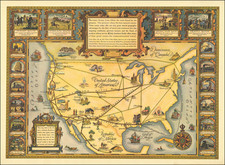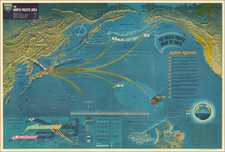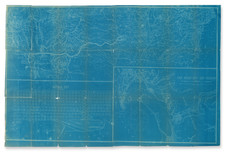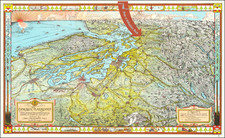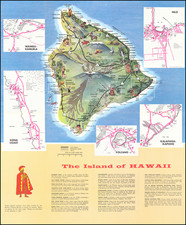Rare Alcatraz Island Occupation Broadside
Extremely rare broadside, celebrating the Occupation of Alcatraz Island, drawn by "Indian" Joe Morris, one of the key figures in the Occupation, and printed by "All-Tribes Arts & Crafts."
The Occupation of Alcatraz, from November 20, 1969, to June 11, 1971, was a 19-month protest in which 89 Native Americans and their supporters took over Alcatraz Island. The present broadside offers a combination birdseye view, allegory, and overview of the occupation.
At the top, a group of Buffalo (representing the Indians of All Tribes), descend upon the Golden Gate Bridge, beginning the occupation of Alcatraz Island, surmounted by the Indian Statue of Liberty, a Native American chief holding a peace pipe facing toward San Francisco and the S.S. Indian Hope. Below the Island is a view of a portion of San Francisco's Embarcadero, between Pier 41 and Pier 45, immediately adjacent to the pier facilities rented by "Indian" Joe Morris, the artist who created the broadside, who was a key figure in the Occupation.
A note at the top left states:
BUFFALO REAPPEARING IN THE WEST --- over the Golden Gate Bridge means the newly awakened generation is on a rampage throughout the land for legal justice - in the High Courts! --- Their lands stolen by treaties which were never honored or abided by!
THIS BATTLE CONTINUES -- ONWARD AND UPWARD as all Indian American youth arises and joins forces in this great cry for justice and equality for their people! . . .
INDIANS OF ALL TRIBES.
"INDIAN JOE" MORRIS
Alcatraz Island Occupation By The Indians of All Tribes (1969-1971)
The occupation of Alcatraz Island by Native Americans, spanning from November 1969 to June 1971, represents a landmark event in the annals of Indigenous activism in North America. Orchestrated by the collective known as Indians of All Tribes (IAT), this movement drew together a broad spectrum of Native American communities, heralding a unified stance in the campaign for Indigenous rights and sovereignty.
The initiative was spearheaded by a cadre of determined activists including Richard Oakes, a Mohawk who emerged as one of the movement's most visible leaders; LaNada Means, who brought her Shoshone Bannock heritage into the struggle; Adam Fortunate Eagle, an Ojibwa visionary; and John Trudell, a Santee Dakota. These figures were joined by others such as Grace Thorpe, daughter of the legendary athlete Jim Thorpe of Sac and Fox descent, who added her voice and organizational skills to the cause.
The occupiers' demands were rooted in historical treaties, notably invoking the Treaty of Fort Laramie (1868), to assert their claim for the reclamation of Alcatraz Island, proposing its transformation into an Indigenous cultural and educational hub. The island quickly became a focal point for media attention, serving as both a literal and symbolic platform for the broader Indigenous rights movement in the United States.
Throughout the occupation, the island saw the establishment of a self-sufficient community, complete with educational programs, health services, and even a radio broadcast, "Radio Free Alcatraz," featuring John Trudell, who became known as "the Voice of Alcatraz."
On the government side, negotiations and interactions involved figures such as Robert Bennett, Commissioner of Indian Affairs, and Vice President Spiro T. Agnew, whose administration faced the complex task of responding to the occupation. The stance of the Nixon administration, through intermediaries, oscillated between attempts at negotiation and the eventual decision to remove the occupiers by force.
The federal government's cessation of the occupation on June 11, 1971, did not mark the end of its impact. Rather, the event catalyzed significant shifts in U.S. policy towards Native American tribes, notably moving away from termination policies and towards self-determination, marking a new era in Indigenous-government relations.
"Indian" Joe Morris
Joe Morris, a Blackfoot and a member of the local longshoreman's union, played a significant role in supporting the Alcatraz occupation by Native Americans from 1969 to 1971. His involvement was crucial in providing logistical support to the occupiers. Morris utilized his position in the union to offer a form of protection to the activists by threatening to close both ports if the occupiers were forcibly removed from the island.
Furthermore, Morris facilitated the movement of supplies and people to Alcatraz by renting space on Pier 40. This logistical support was vital for the sustenance of the occupation, ensuring a steady flow of necessities to the island and bolstering the occupiers' efforts to maintain their presence.
Rarity
The broadside is very rare.
We locate one other surviving example in the Oakland Museum of Art.
This is one two such broadsides attributed to Morris, the other can be seen here.









![[San Diego & Vicinity] Home Federal Country](https://storage.googleapis.com/raremaps/img/small/71369.jpg)
